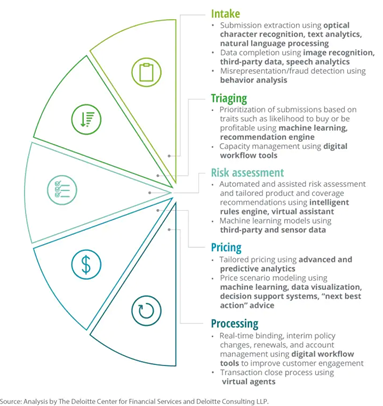Blog
Process Mining in Insurance: Accelerate Automation
Contact Us
It’s time for the insurance industry and financial institutions to update their underwriting processes. Rather than spending work efforts on the traditional process of collecting and managing large volumes of data and organizing policies from various internal and external data sources, your underwriters should be allowed to leverage their expertise and experience. Intelligent automation (IA) empowers them to develop the rules and training for automated solutions that will improve their insurance, loan or mortgage underwriting processes and give valuable time back to them.
Underwriting functions exist in highly regulated spheres, requiring good compliance reporting and auditability, from verifying loan decisions to assessing risks, and automation can help alleviate the slowdowns in these multistep processes.
In a broad brushstroke, underwriting activities include intake, triaging, identifying risks, pricing and processing. There are a lot of steps within each of these categories, and in manual data entry, they’re time-consuming and prone to human error.
There are variations of underwriting automation that can be appropriately deployed to streamline entire processes. Intelligent automation (IA) involves robotic process automation (RPA) to mimic human actions on repeatable tasks while artificial intelligence (AI) expands that to include a digital workforce capable of completing end-to-end processes quickly and accurately. Business process management (BPM) orchestrates the work between systems, people and your digital workforce.

Underwriting in insurance and finances involves a series of complex steps, and when done manually by your human underwriters, these steps can be error-prone. But with IA, you can automate these time-consuming, repetitive tasks to streamline your workflow and simplify the underwriting process. This frees up your people to work on higher-value, profit-driven or customer-facing initiatives.
Essentially, automated insurance underwriting is about simplifying and streamlining. You want faster, better and more. IA can do that by reducing manual efforts and performing tasks quickly following the underwriting rules fed to your digital workers. Here are some of the benefits of automating the underwriting process:
Meeting high consumer expectations and giving a good customer experience is key to any successful business, and financial institutions and insurance companies are no exception. With automated underwriting systems, you can centralize your policyholder’s personal data in real time, ensuring easier accessibility for authorized users. There’s also 24/7 support along the customer journey, answering requests, updating a customer’s insurance policy, etc., automatically with the machine learning (ML) capabilities of your digital workforce.
Underwriting processes include huge amounts of data, often derived from various sources. IA allows businesses to organize and access their data more easily and connect disparate underwriting platforms and systems for a more cohesive workflow. Plus, with AI-powered predictive analytics, your digital workers can search through hundreds of data sources quickly to streamline the risk assessment process and uncover any required data, helping augment underwriting decisions and saving a lot of useful time that used to be spent on manual underwriting.
With automated insurance underwriting, your digital workers reduce your cycle times by removing the repetitive manual tasks that tend to be error-prone, and freeing up more time for your underwriters to work on higher-value tasks. By streamlining your straight-through processing, IA increases your capacity, which can lead to higher productivity and revenue. Digital workers also help you with faster response times by creating accurate quotes, issuing policies and helping meet customer expectations sooner.
Insurance carriers must work with high regulatory requirements, meaning reporting and transparency are key to avoiding penalties and fines and ensuring data security. An IA underwriting software should offer real-time visibility into how your processes are performing, ensuring they follow the set regulatory and business rules and continue to work at peak performance without bottlenecks or delays.
IA augments work, making your agent experience better by saving them from the boring, repetitive manual work and giving them easier access to the data they need to do their jobs. By automating these simpler tasks, your employees have more time and resources to bring a higher yield back to your business, improving agent productivity.
Your digital workers will check and verify each policy against your underwriting guidelines and send instant alerts for anything that doesn’t match, helping you pinpoint potential risks sooner when evaluating an applicant for risk level and which policies would suit them best.
When you’re looking for an intelligent automation provider for underwriting processes, here’s what you should look out for:
SS&C Blue Prism can help you transform your underwriting processes through the power of intelligent automation. It’s time to start thinking bigger about your operations.
Any insurance company or financial institution looking to improve their risk assessment and underwriting capabilities can benefit from automation. But you don’t have to limit IA to your underwriting department. It can manage processes across multiple systems and departments through a centralized, user-friendly platform.
Read more about insurance automation for transforming claims automation, underwriting, customer experience and back-office tasks.
Your automation journey starts with deciding which processes you want to automate by determining where your business will benefit most from digital workers. Following automation operating models such as the SS&C | Blue Prism® Robotic Operating Model™ (ROM2) can help you prioritize your processes and identify your best automation candidates.
An insurance company in the U.K. benefited from intelligent automation to bridge system gaps and boost their process efficiency. Read more about their success here.
The global insurer Allianz Group used a digital workforce to apply structure and meaning to their unstructured data, benefiting their claims and operations processes. Read more about their success here.
If your network blocks YouTube, you may not be able to view the video on this page. In this case, please use another device. Pressing play on the video will set third-party YouTube cookies. Please read our Cookies Policy for more information.